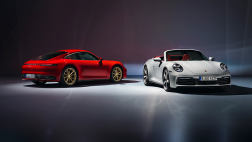Ford has pulled the covers off two electrified vans at the IAA Commercial Vehicle show in Hannover, showcasing a plug-in hybrid mid-size Transit Connect and a larger 48V mild-hybrid Transit.
The Blue Oval has not ruled out an Australian launch, meaning these vehicles could represent Ford Australia's first crack at mainstream electrification.
Internationally, both the van models will go on sale sometime in the middle of 2019.
.jpg)
The Transit Connect PHEV (plug-in hybrid electric vehicle) makes use of an electric motor that drives the front wheels, with a 1.0-litre three-cylinder petrol engine generating electricity to a 14kWh lithium-ion battery.
Ford claims a 500 kilometre driving range with a full tank of petrol, and a charging time from three hours connected to a 32-amp power supply.
It also boasts a 1000kg payload, and can be driven up to 50 kilometres on battery power alone.
Meanwhile, the two-tonne Transit mHEV (mild-hybrid electric vehicle) uses a belt-driven starter-generator replacing the conventional alternator, providing regenerative braking to an air-cooled lithium-ion battery pack.
The mild-hybrid set-up also adds torque during acceleration, and powers the vehicle's ancillaries to increase efficiency.
Speaking of efficiency, Ford claims the mHev is 3.0 per cent more efficient than the standard diesel variant it's based on, or up to 8.0 per cent in heavy traffic.
Ford Australia product communications manager Damion Smy was unable to make any concrete statements regarding a local launch, however he did say the brand "wouldn't rule anything out".
.jpg)
He also mentioned that electrification could improve the total running costs and efficiency of the Transit.
"That (cost of ownership) is a really sharp focus for Transit, so if the hybrid was to come in with lower running costs that would be great," he said.
Mr Smy suggested the Transit has strong appeal to brand-conscious buyers, and that the eco-friendly image associated with a hybrid van could help drive sales Down Under.
"A lot of people buy for their particular brand image, so you can buy (Transit) in the colour you want… A lot of it is about the image of the company as well, so that might be where the hybrid might work in that sense," he said.
"We like high-spec vehicles in this market, which is why Transit is the highest-spec model, and sells at a higher price because customers are looking for a better-equipped vehicle."

.jpg)
.jpg)

.jpg)
.jpg)


.jpg)

.jpg)


.jpg)



.jpg)

.jpg)

.jpg)

.jpg)
.jpg)